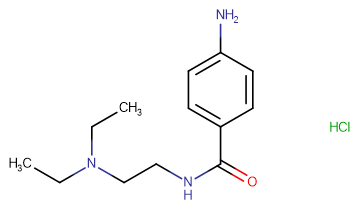
Procainamide hydrochloride
CAS No. 614-39-1
Procainamide hydrochloride ( Procainamide Hydrochloride; Procainamide Hcl; Pronestyl; Procanbid; Procapan; Procaine Amide )
Catalog No. M15317 CAS No. 614-39-1
Procainamide hydrochloride is a class Ia antiarrhythmic drug that is structurally-related to procaine.
Purity : >98%(HPLC)
 COA
COA
 Datasheet
Datasheet
 HNMR
HNMR
 HPLC
HPLC
 MSDS
MSDS
 Handing Instructions
Handing Instructions
| Size | Price / USD | Stock | Quantity |
| 50MG | 37 | In Stock |


|
| 100MG | 53 | In Stock |


|
| 200MG | 77 | In Stock |


|
| 500MG | Get Quote | In Stock |


|
| 1G | Get Quote | In Stock |


|
Biological Information
-
Product NameProcainamide hydrochloride
-
NoteResearch use only, not for human use.
-
Brief DescriptionProcainamide hydrochloride is a class Ia antiarrhythmic drug that is structurally-related to procaine.
-
DescriptionProcainamide hydrochloride is a class Ia antiarrhythmic drug that is structurally-related to procaine.
-
SynonymsProcainamide Hydrochloride; Procainamide Hcl; Pronestyl; Procanbid; Procapan; Procaine Amide
-
PathwayEndocrinology/Hormones
-
TargetAChR
-
RecptorAChR; DNA (cytosine-5)-methyltransferase 1; Sodium Channel
-
Research AreaNeurological Disease
-
Indication——
Chemical Information
-
CAS Number614-39-1
-
Formula Weight271.79
-
Molecular FormulaC13H21N3O·HCl
-
Purity>98%(HPLC)
-
SolubilityEthanol: 54 mg/mL warmed (198.68 mM); Water: 54 mg/mL (198.68 mM); DMSO: 54 mg/mL (198.68 mM)
-
SMILESCCN(CC)CCNC(=O)C1=CC=C(C=C1)N.Cl
-
Chemical Name4-amino-N-[2-(diethylamino)ethyl]benzamide;hydrochloride
Shipping & Storage Information
-
Storage(-20℃)
-
ShippingWith Ice Pack
-
Stability≥ 2 years
Reference
1.Wojnarowska Z, et al. J Chem Phys. 2012 Apr 28;136(16):164507.
molnova catalog


related products
-
Ipratropium bromide ...
Ipratropium Bromide is a muscarinic antagonist, bronchodilator, N-Isopropyl salt of atropine.
-
L-Hyoscyamine
L-Hyoscyamine is a chemical compound, a tropane alkaloid it is the levo-isomer to atropine.
-
Darifenacin HBr
Darifenacin is a selective muscarinic receptor antagonist.



 Cart
Cart
 sales@molnova.com
sales@molnova.com


